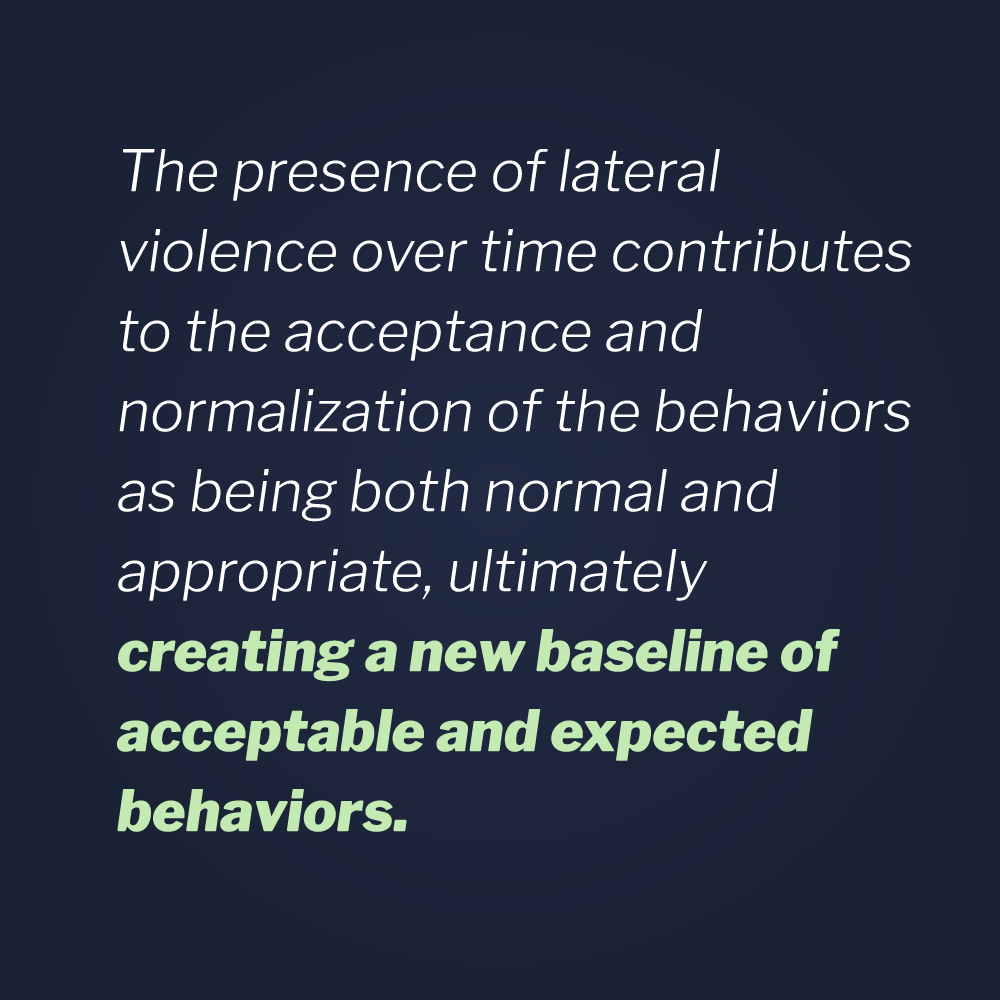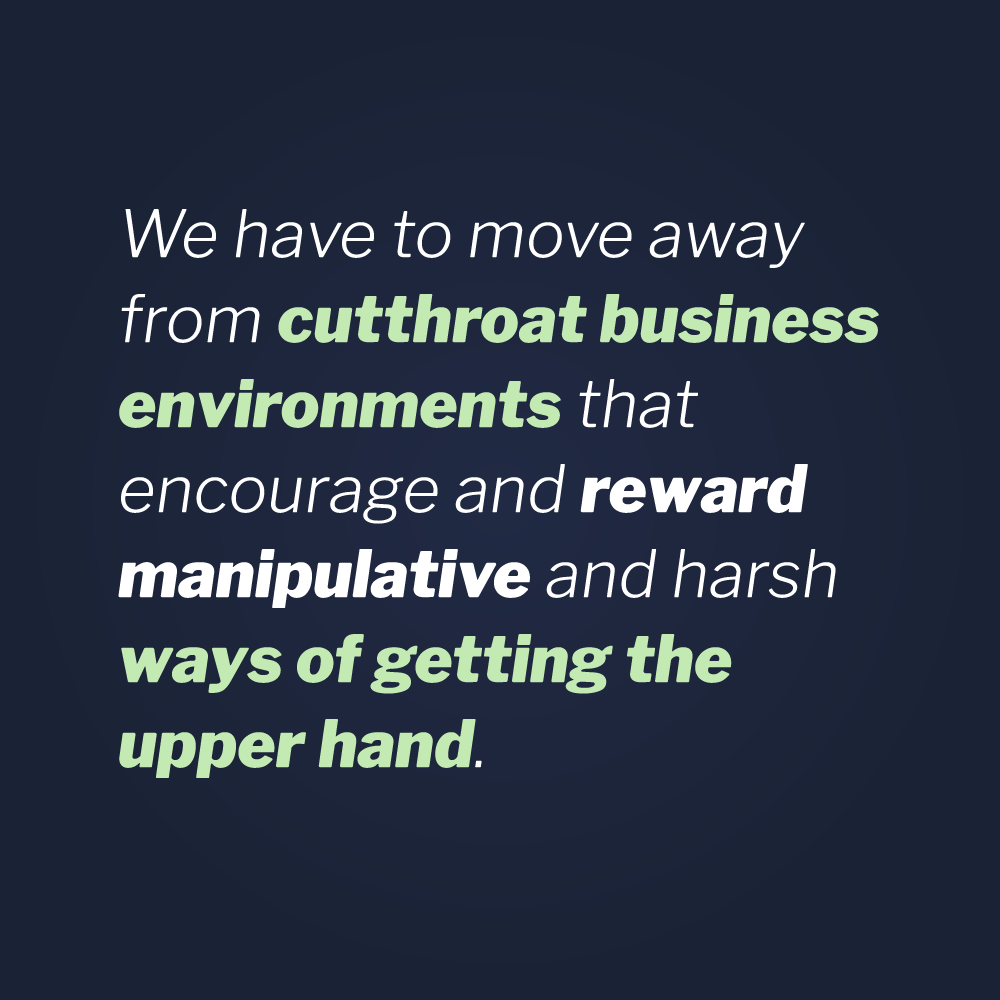Enjoy this excerpt from one of our published books.
Chapter 1
Lateral Violence as a part of workplace violence
If I had only changed myself first …
“When I was young and free and my imagination had no limits, I dreamed of changing the world. As I grew older and wiser and realized the world would not change I shortened my sights somewhat and decided to change only my country, but it too seemed immovable. As I grew into my twilight years I settled on changing only my family and those closest to me, but alas they would have none of it. Now as I lay on my deathbed and I suddenly realize that if I had only changed myself first, then by example I could perhaps have changed my family, and from their inspiration and encouragement to me I would have been better able to help my country and from there I may even have been able to change the world.”
- From the tomb of an Anglican Bishop in Westminster Abbey, 1100 A.D.
The paradigm of acceptance of violence in the workplace must be abandoned. Instead, we must create environments of care by developing and reinforcing professional standards that are incompatible with emotional and physical violence.
We all know what acts of physical violence look like, but recognizing the subtle signs of lateral violence is much more difficult. However, it is critical in our efforts to eliminate workplace violence to understand the distinction, as lateral violence feeds directly into physical violence. Lateral violence is any non-physical, but harmful, behavior between members of a community (e.g., workplace employees). This behavior can be passive-aggressive, aggressive, or even hostile.
While individual acts of lateral violence can appear relatively harmless, they ultimately create a toxic environment that takes a toll on employee morale and productivity, hindering the success of the organizations for which they work.
Historically, the term lateral violence has been used interchangeably with terms such as horizontal violence, bullying, incivility, hazing, disruptive behavior, relational aggression, and workplace dysfunction. These behaviors often slip under the radar as “innocent” remarks or actions that have ambiguous intent, but research has shown that these uncivil behaviors directly impact an employee’s ability to effectively perform their job duties. (Cooper & Hoel, 2000)
The subtle nature and absence of a widely understood and agreed- upon definition of lateral violence contributes to the minimization and lack of recognition of its prevalence and subsequently makes it hard to identify, mitigate, regulate, enforce, and remove it from the workplace.
Although often associated with the nursing profession, the problem of lateral violence can exist in any environment. Anyone can engage in laterally violent behavior, but it is typically perpetrated by people who view themselves as superior to others. Organizational managers and more experienced employees are the most frequent perpetrators of lateral violence, making it difficult for lower-level or less experienced employees to report their abuse for fear of retaliation, among other reasons. This power dynamic can manifest itself in many subtle (and not so subtle) ways.
Even though lateral violence often slips under the radar, the blunt reality is that it can lead to physical violence and even death. For example, there is a direct correlation between workplace lateral violence and active shooter incidents. (Modell, 2013) Research has also indicated that behavior in response to lateral violence incidents includes professional disengagement, avoidance, intent to resign, and, most frighteningly, physical retaliation. (Morrison, Lindo, Aiken, & Chin, 2017) In another study referenced in the book The Price of Incivility, Drs. Christine Porath and Christine Pearson found that a shocking 94% of victims claim they settle their scores with the offenders, sometimes with physical violence.
Therefore, lateral violence is not only an issue of improving workplace morale; it can be a matter of life and death.
It is important to note here that those who have been repeatedly bullied, disrespected, and treated with indignity, carry that frustration with them wherever they go. Their frustration can boil over and escalate to physical violence towards anyone at any time - not just towards fellow co-workers while at work.
Conversely, those consistently exposed to external stressors outside of work (e.g., relationship issues, divorce, child behavior, financial challenges, mental illness, and/or drug and alcohol addiction) can bring their frustration to work and unexpectedly lash out towards those within their organization.
The point being that lateral violence is not just a workplace problem. Lateral violence can lead to problems outside the workplace and, if present outside of work, can lead to problems within the workplace.
Laterally violent behaviors persist over time but often through discrete, relatively short-lived acts. They are often perpetrated by those with little to no connection to the abused. Instead, the only trigger may be random acts of bullying, including isolation, disrespect, and fear for their job and their future. We must not ever underestimate the “place we go” and the deeply painful emotions of fear, anger, hate, suffering, and contempt that we experience when we feel like we’ve been wronged. The core elements of underlying human emotion here can drive drastic behavioral responses.
“If you never heal from what hurt you, you’ll bleed on those who didn’t cut you.”
- Author unknown
There is no single explanation for the prevalence of lateral violence in the workplace, but research has shown that institutional power structures, job-related stress, and organizational culture (including the behavioral expectations of the organization’s underlying social contract) play a large role. (Englander & Raffalli, 2012) A social contract is an agreement of acceptable behavior amongst a group of people.
Workplace incivility is often described as “low intensity” conduct with ambiguous intent of harm. This includes being mildly (but regularly) rude or discourteous or violating behavioral norms in the workplace, such as the basic norm of mutual respect. It often manifests itself as the exchange of “seemingly inconsequential inconsiderate words and deeds that violate conventional norms of workplace conduct.” (Porath & Pearson, 2013)
The description of “ambiguous intent of harm” is what distinguishes workplace incivility from other forms of interpersonal mistreatment. It is the vagueness of intent in these situations that make workplace incivility difficult to understand. Furthermore, whether or not behaviors or words are uncivil depends on how the receiver perceives them. Gossiping, exclusion, and hostility consistently rank among the top-cited forms of workplace incivility. (Bambi, Foà, De Felippis, Lucchini, Guazzini, & Rasero, 2018)
In the workplace, poorly managed lateral violence has serious implications, including compromised physical health, mental health, and other psychosocial hazards; high turnover; poor morale; low productivity; and reduced quality of products manufactured and services provided. Additionally, it directly leads to the loss of an organization’s most valuable resource: employees. In one study, 60% of nurses who left their jobs within six months of hire attributed it to being bullied and harassed by veteran staff. In another, 80% of people reported holding back effort or lost time as a result of an uncivil interaction. (Porath & Pearson, 2012)
In essential services, such as healthcare, the cost of lateral violence is severe. In medicine, for instance, lateral violence negatively affects the quality of care, patient outcomes, and even mortality. Georgetown University’s Dr. Christine Porath notes that workplace incivility can cause people to miss the transfer of critical information, resulting in a 17% loss in information retention, a 50% increase in medical mathematical errors, and a need for more time to make decisions. Facing consistent workplace incivility shuts down our brains at work, and in healthcare, it could be a matter of life and death.
Reduction in teamwork and functionality among first responders, corrections workers, and others engaged in high-risk work caused by lateral violence directly impacts their safety and the safety of others. These examples and more will be discussed in more detail later in the book.
Is Violence Really “Just Part of the Job?”
At one time or another, I’m sure we’ve all heard that dismissive phrase, that “so and so’s” behavior is just the way it is and that there’s “nothing you can do about it.” But is that really true?
“To create an organizational culture incompatible with emotional and physical violence, we must first dispel the myth that toxic behaviors, disrespect, and violence are just ‘part of the job.’ Understanding this puts us on a path towards a safer and more respectful workplace experience.”
- Joel Lashley, Confidence in Conflict for Health Care Professionals: Creating an environment of care that is incompatible with violence, Dispelling the Myth: Violence is Just Part of the Job, 2015, P.44
Just like with any other cycle of violence, if we accept this myth, we become paralyzed to act when action may be necessary.
Because so many people embrace this myth, the majority of schools are unsafe for children who find themselves endlessly bullied and hopeless.
Because of this myth, the majority of workplaces are unhealthy for adults who find themselves unable to navigate the personal politics, power struggles, and overall minefield of disrespectful and indignant behavior.
Because of this myth, residents and staff of group homes for people with psychiatric conditions and brain-based disorders are commonly locked in a daily cycle of violence and fear. And medical staff are assaulted on the job at rates at least seven times more than average.
Why is it that if a nurse threatened a patient, they would be fired without question? But when a co-worker makes an inappropriate comment, publicly berates, or threatens another employee, people are hesitant to take any action. It is because we have normalized these behaviors as acceptable, slowly, over time.
Just as we must ensure the safety of those under our care, we must ensure the emotional and physical safety of our employees— all employees.
Challenge yourself and others to avoid falling into the trap of the myth that violence is just part of the job. Avoid excuses for rudeness that include:
- “That’s just the way they talk, They didn’t mean anything by it.”
- “It’s nothing. Ignore it.”
- “We all face it. Toughen up.”
- “I’d stay quiet if I were you. She is our star performer.”
- “It’s always been that way. No supervisor will do anything about it.”
All these excuses do is validate, perpetuate, and condone the behavior of those perpetrating!
The Role of Lateral Violence as Part of Workplace Violence
Incivility, bullying, and workplace violence are part of a larger complex phenomenon that includes a “constellation of harmful actions taken and those not taken” in the workplace. (Saltzberg, 2011, p. 229)
The phrase “actions taken and not taken” provides an overarching framework that includes perpetrating these acts, as well as failing to take action when action is warranted or required.
The U.S. Department of Labor defines workplace violence as “an action (verbal, written, or physical aggression) which is intended to control or cause, or is capable of causing, death or serious bodily injury to oneself or others, or property damage. Workplace violence includes abusive behavior toward authority, intimidating or harassing behavior, and threats.”
OSHA addresses employee complaints of workplace violence and assesses employers based on OSHA’s General Duty Clause, Section 5(a)(1) of the Occupational Safety and Health Act of 1970:
“(a) Each employer shall furnish to each employee employment and a place of employment which are free from recognized hazards that are causing or are likely to cause death or serious physical harm to employees.”
Essentially, employers are on notice. They must provide a safe workplace environment, and allowing violent behaviors in any form is a failure to do so. Perhaps the failure to stop rumors or gossip is not as obvious as the need to post signage near a trip or fall hazard, but the underlying premise is the same: employers have a duty to identify workplace hazards and risks and take actions to mitigate them.
Additionally, employees will face adversity by being passed over for a raise, seeing others singlehandedly recognized for shared accomplishments or failing to achieve a long-sought-after promotion. Personal relationships and history between employees can also cause festering undercurrents and outright disagreements and, over time, can bubble to the surface in the form of resentment and retaliatory acts.
According to the Workplace Bullying Institute, the following acts and behaviors fall under the traditional definition of workplace bullying, which is a form of lateral violence:
Repeated, health-harming mistreatment of one or more persons (the targets) by one or more perpetrators that takes one or more of the following forms: verbal abuse; offensive conduct/behaviors (including nonverbal) which are threatening, humiliating, or intimidating; [and] work interference—sabotage—which prevents work from getting done.
This includes:
- Making racial, ethnic, or religious jokes.
- Making jokes concerning another person’s body shape, size, or physical ability/disability.
- Hazing.
- Intimidating.
- Coercion.
- Excluding coworkers.
- Making inappropriate comments (non-verbal or verbal).
- Making sexually provocative jokes or statements.
- Delivering unwanted sexual attention.
- Making jokes that violate what is socially acceptable.
- Playing intentionally hurtful practical jokes.
- Making other remarks that can be reasonably perceived as rude, offensive, or improper.
Any of these situations can lead to conflict, which can escalate to violence.
Bottom line, lateral violence (non-physical, but harmful, behavior between members of a community) can lead to physical violence and workplace violence from external sources which can manifest in these forms:
- Weapon use, such as with an armed physical assault.
- Unarmed physical assault, such as poking, slapping, or grabbing.
- Threats of harm or death (veiled, indirect, or direct).
- Stalking or displaying undue personal focus (in-person and/or on social media).
- Damaged property.
- Active shooter incidents.
- Sexual assault.
According to the U.S. Department of Labor, some two million American workers are victims of workplace violence each year; however, this number is likely much higher as workplace violence incidents often go unreported for a variety of reasons, such as fear of retaliation or the belief that it “just isn’t worth it” to report it.
There is also greater visibility of the problem of workplace violence with the presence of security cameras and cell phone cameras. Almost every interaction is captured on video, which can show up instantly on social media or the evening news.
A 2018 survey by Everbridge/ASIS International found that 67% of executives and leaders were more concerned about employee safety than just two years prior. A 2019 survey by the Society for Human Resource Management found that incidents of violence were up 36% since 2012, and one out of seven employees feel unsafe at work.
Furthermore, the Workplace Violence Research Institute estimated costs of workplace violence to U.S. businesses at $360 billion per year due to turnover and decreased work productivity alone. Current hospital turnover is now at 19.5%, with a staggering 500,000 experienced nurses set to retire in 2022.
Core Causes of Lateral Violence
Institutional power structures (including rank, title, favoritism, and nepotism), job-related stress (distribution of an improper workload, for example), and organizational culture play large roles in enabling lateral violence. Internal politics (such as jockeying for promotions) and competing metrics (such as productivity or profit margin) also contribute.
The presence of lateral violence over time contributes to the acceptance and normalization of the behaviors as being both normal and appropriate, ultimately creating a new baseline of acceptable and expected behaviors.
as being both normal and appropriate, ultimately creating a new baseline of acceptable and expected behaviors.
The new behaviors become ingrained in the culture, and those who continue to behave that way view it as a rite of passage, or initiation, similar to hazing, i.e., “Well, I was treated this way when I started, so now you’re going to pay your dues too.”
When you’re immersed in a workplace culture that has normalized lateral violence, it is nearly impossible to see and understand how toxic it truly is. It is often not until after an employee quits (or heads down a path resulting in termination) that they can look back, take a deep breath, and reflect on the situation. It is then and only then that they realize just how much the environment has been destroying them over time.
I have talked to dozens of people over the years who have quit their jobs. They often cite being exhausted, exasperated, and generally unsure of how it had come to that point. They talk about how miserable they were at work and how much better they feel— emotionally, mentally, and physically— just because they removed themselves from that environment. They cite leaving “bad bosses” and “toxic environments” far more than quitting because of the nature of the work itself.
It is heartbreaking to hear, but hindsight is always 20/20.
Laterally violent behaviors are often perpetuated by those who view themselves as superior to others (either explicitly by rank or title or implicitly through their unofficial role in the workplace or as a byproduct of their personal belief system). Please note that if there is an explicit hierarchical difference (such as legitimately being someone’s boss, manager, or supervisor) between the offender and the victimized, this behavior is often categorized as “vertical violence.”
Oftentimes, people believe or perceive that employees of lower rank or status are inferior to those of higher status. Examples of this power struggle play out daily in healthcare systems worldwide. Hospital administrators and patients often consider nurses inferior to physicians, certified nursing assistants inferior to nurses, and support staff inferior to all. Physicians often receive the praise, even though the nurse’s skill and commitment directly improved patient outcomes. As a result, many nurses feel powerless and undervalued, leading to significant internal frustration. Some researchers believe that lateral violence is the outward expression of this frustration. (Bambi et al., 2018)
Someone’s repeated unreasonable behavior, where the behavior creates a risk to health and safety, may be a result of power imbalances related to their position in the organization. A power difference may be caused by experience, age, the length of time the person has been with the organization, social position, or other factors between the person perpetrating the bullying behavior and the person or people who are targeted by the bullying behavior.
the bullying behavior.
Additionally, increasing latent tensions, such as frustration related to the unequal power dynamic, can lead to overt conflicts and power struggles in the workplace. Overt conflict manifests itself as conflicts of interests, disputes of rights, visible signs of unequal power or treatment, and feelings of being unsupported with limited resources.
We have to move away from cultural expectations that teach and allow us to humiliate or dehumanize others as a way to achieve power or respect. We have to move away from cutthroat business environments that encourage and reward manipulative and harsh ways of getting the upper hand. We must challenge ourselves to transform the dynamic that it is acceptable for anyone to get away with treating others as inferior because of their social status.
Core Costs of Lateral Violence
As adults, we assume that we would have the freedom, resources, and autonomy to identify and walk away from an abusive and/or toxic situation. But with respect to workplace violence, we are obligated to return day in and day out to the scene (or source) of harassment (unless, of course, we quit).
The abuse that culminates in the professional world mirrors some of the long-term physiological and psychological effects of long-term victimization of school bullying.
If the benefit of retaining employees and preventing emotional trauma is not reason enough to end lateral violence, employers and organizational leadership should also consider the exceptional costs associated with condoning and maintaining a toxic workplace environment.
Consider these additional, non-insurable organizational costs and losses:
Production losses:
- Increased overhead costs while production is reduced.
- Time lost due to preoccupation with a negative situation.
- Reduced productivity as a result of workplace incivility. (Oyeleye, Hanson, O’Connor & Dunn, 2013)
- Production lost to absenteeism or presenteeism of the offender. Workplace incivility has been found to be a predictive factor of commitment to work (Smith et al., 2010) and absenteeism. (Bambi et al., 2018 and Zia ud-Din, 2017)
- Time lost due to internal transfers.
- Time lost when employees look for new jobs.
- Time lost to prepare a case in defense of a civil suit.
- Loss of skill or experience when a person leaves.
- Loss of invaluable institutional knowledge.
- Lower production rate of lesser experienced replacement workers.
Wages lost:
- Interruption of work due to the negative situation.
- Cost of replacing staff (recruiting, onboarding).
According to the 2019 National Healthcare Retention & RN Staffing Report, published by Nursing Solutions, Inc., each percent change in nurse turnover will cost (or save) the average hospital an additional $328,400.
Associated costs:
- Investigations (internal and/or external).
- Implementing new reporting recommendations.
- Legal costs related to common law claims.
- Costs associated with training new employees.
- An increase in business insurance costs due to claims.
Intangible costs:
- Lower employee commitment resulting in lower performance, decreased motivation, decreased loyalty, decreased morale, and threat or damage to organizational reputation.
No organization will have insurance enough to cover the time and emotional toll of having an organizational culture and disposition of disrespecting others. For example, we often ignore (or fail to address) the substantial implications of allowing harmful statements, or “toxic talk,” to go unchecked.
Generally speaking, it starts with “water cooler talk” or gossip during lunch breaks. What some perceive as harmless and spout off without a second thought may emotionally or professionally devastate others.
For example, consider a situation where a human resources employee had to make a tough executive decision, one that was not in favor of a friend of yours. Soon that friend is spreading rumors— unfactual, biased, or slanted information that led to the decision. Soon after, those rumors spiral and are injected with additional venom, anger, and frustration as they permeate throughout the organization. This slanted spiral of information leads to a dangerous polarization of events (or ideas) and often damages the reputations of all involved. In addition to the steep individual emotional toil, defamation of character and injury to reputation lawsuits are costly and extremely time-consuming, taking years of dedicated legal resources to resolve.
Additional Consequences of Lateral Violence
Truly, the consequences and costs of lateral violence cannot be fully understood as standalone pieces; the sum is greater than its parts. The magnitude of organizational costs is compounded by the other, more elusive costs of workplace incivility, such as the specific costs to individuals. These costs extend to and have repercussions far beyond those who have been directly victimized. They extend to and are experienced by all employees immersed in a disrespectful and toxic culture.
Consider these staggering unethical costs to the individual, supported by decades of research, summarized in the groundbreaking meta-analysis study “Workplace incivility, lateral violence and bullying among nurses. A review about their prevalence and related factors,” conducted by Bambi et al., 2018.
Psychosocial hazards and adverse health outcomes can include:
- Post-traumatic stress.
- Post-traumatic stress disorder.
- Depression.
- Anxiety. Workplace incivility has a positive predictive function to generate anxiety and burnout. (Bambi et al., 2018)
- Apathy.
- Loss of sleep.
- Loss of appetite.
- Lower self-esteem and/or self-confidence.
- Anger/rage.
- Chronic fatigue. Workplace incivility has a significant predictive factor for emotive exhaustion. (Spence-Laschinger HK, Leiter M, Day A, Gilin D, (2009)
- Compassion fatigue.
- Suicidal thoughts.
- Irritability.
- Nervousness of victimization and revictimization.
- Headaches, stomach aches, and/or abdominal pain.
- Nausea and stomach upset. Workplace incivility is directly correlated with physical symptoms. (Leiter MP, Price SL, Spence Laschinger HK, 2010)
- Social withdrawal.
- Obesity.
- Heart, lung, and/or liver disease.
- Cancer.
Negative impact on quality of life:
- Increased dread of going to work.
- Reduced job satisfaction. (Topa & Moriano, 2013)
- Burnout. There is a linear relationship between workplace incivility and burnout. (Elmblad R, Kodjebacheva G, Lebeck L, 2014)
- Increased propensity to leave/turnover intention. (Lieter et al., 2010)
- Increased chemical abuse (Vartia MA-L., 2013)
The slowly increasing awareness by employees that it is their right to have a safe and healthy workplace is exciting, but that’s an example of something that should have happened a long time ago.
Employers need to realize that the “soft stuff ” is really the “hard stuff,” meaning that managing behaviors in the workplace can affect the bottom line much more than sales analytics and penny-pinching.
Key Takeaways
- We must abandon the acceptance of violence and incivility in the workplace.
- Lateral violence is non-physical, but harmful, behavior between members of a community (e.g., workplace employees).
- Institutional power structures, job-related stress, and organizational culture play a large role in enabling workplace violence. Internal politics and competition also contribute.
- We can combat the myth that violence is “just part of the job” by developing and reinforcing professional standards that are incompatible with emotional and physical violence.
- The true costs of lateral violence, incivility, and working in a toxic workplace culture are measurable by the effects on both the organization and the individual.
- Feeling disrespected and undervalued in the workplace is the number one reason people quit their jobs.









